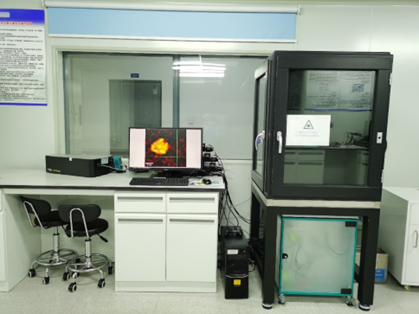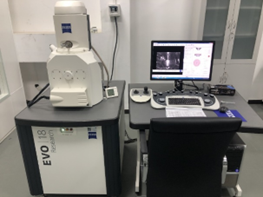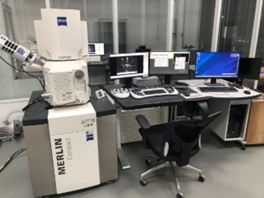This facility is used to study material with instruments, characterization technology and method.
Aims
This facility aims to offer material structure characterization, spectroscopy characterization, composition analysis, physical property measurement, microscope and Imaging observation for materials, mainly used in areas such as physics, chemistry and materials frontier research and graduate teaching.
Test Capability
The facility has several instruments dedicated to material testing, including:
Industrial computerized tomography (XCT): It performs non-destructive 3D imaging of materials, enabling visualization and analysis of internal defects, inclusions, cracks, and their evolution.
Glow Discharge Optical Emission Spectrometer (GD-OES): This instrument provides high-sensitivity elemental analysis of solid materials, especially metals. It can determine the composition of solid materials and is particularly useful for analyzing depth profiles and identifying trace elements crucial for understanding material performance and degradation.
Environmental Scanning Electron Microscope (ESEM): This versatile instrument provides a range of analytical capabilities, including high-resolution microstructural imaging and analysis, fractography for failure analysis, grain size and crystal orientation analysis.
Scanning Electron Microscope (SEM): This versatile instrument provides a range of analytical capabilities, including high-resolution microstructural imaging and analysis, fractography for failure analysis, grain size and crystal orientation analysis, micro-area chemical composition analysis (EDS), Phase identification of unknown materials and In-situ observation of micromechanical behavior.
White Light Interferometry (WLI): It enables detailed characterization of surface topography and roughness, making it valuable for studying corrosion damage, wear, and other surface modifications. This data can be used for failure analysis and performance evaluation.
Atomic Force Microscope (AFM): The AFM characterizes material surfaces at the nanoscale, providing information on topography, dimensions, and various physical properties, including electrical, magnetic, and mechanical characteristics.
Confocal Raman Spectrometer:This instrument analyzes the chemical composition and molecular structure of materials. It can be used to identify different material components, map stress distributions, and study other properties related to molecular vibrations.
Scanning electrochemical system: This instrument allows for in-situ electrochemical measurements at a microscopic level for corrosion analysis of metallic materials, potential distribution in welded samples, identification of anodic and cathodic regions on metal surfaces.
Optical Microscopy: This system performs traditional microscopic examination of materials for microstructural analysis, including phase identification, grain size determination, and defect characterization.
X-ray Diffractometer (XRD): This instrument analyzes the crystallographic structure, phase composition, and residual stress of materials. It can perform both bulk and micro-area XRD analysis, enabling detailed characterization of material properties.
Inductively Coupled Plasma Optical Emission Spectrometer (ICP-OES): This instrument provides quantitative elemental analysis of liquid and solid samples, capable of measuring the total concentration of 71 different elements. This is particularly useful for determining the composition of alloys, environmental samples, and other complex materials.
Ion Chromatography (IC): This technique measures the concentration of anions in liquid samples and water-soluble solids. It's commonly used for analyzing water quality, identifying impurities, and studying ionic species in various materials.
Handheld Alloy Analyzer: This portable instrument provides rapid, non-destructive identification and compositional analysis of metal alloys. It's useful for on-site material verification and sorting.
Ultraviolet-Visible Spectrophotometer (UV-Vis): This instrument measures the absorbance and transmittance of light through a sample, providing information about the concentration of light-absorbing species and enabling quantitative analysis based on Beer-Lambert Law. It's widely used for chemical analysis and material characterization.
Sum Frequency Generation Vibrational Spectroscopy (SFG-VS): SFG-VS is a nonlinear optical spectroscopy technique that selectively probes molecules located at the interface, providing information about their orientation and vibrational modes. This is crucial for understanding various interfacial phenomena, such as catalysis, corrosion, and biofilm formation.
Vickers hardness tester: This instrument measures the hardness of materials, providing insights into their mechanical properties and resistance to deformation.
Confocal laser scanning microscope: This high-resolution imaging technique creates optical sections of a sample, allowing for 3D reconstruction and detailed visualization of internal structures. It's commonly used for biological imaging but can also be applied to materials science for characterizing surface features and internal microstructures.
Advantages of the Facility
This facility delivers advanced instruments and expertise to commercial and research organizations. It owns highly qualified technical personnel and the equipment of the latest generation.
These instruments are operated under faculty supervision with training by technicians. They are also available to researchers from academia and industry. If you would like to find out more about these instruments, please contact us, and provide us with a brief information about your interests.





Phone:+86-10-62333510
Email:ncms@ustb.edu.cn
Address: 12 Kunlun Road,Changping District, Beijing, 100026